IANA Releases 2021’s Second Quarter Intermodal Quarterly Report
Second Quarter 2021 Intermodal Volume
Intermodal volumes improved for the fourth consecutive quarter, surging 20.4% year-over-year in Q2. This quarter’s double-digit increase was the largest quarterly gain since Q3 of 2010 and was also the sixth quarter with a double-digit growth rate in the history of the data. On a seasonally adjusted basis, total intermodal volume was 1.7% higher in Q2 than the previous quarter. This was anticipated, as inclement winter weather and service shutdowns held back volume in Q1. In Q2, all three market sectors had impressive growth. The domestic market, which consists of trailers and domestic containers, improved by 16.1% year-over-year. Trailer loads jumped 18.5% this quarter, compared to a 14.0% decline in Q2 of 2020. Domestic container traffic rose slightly less than trailers, at a pace of 15.7% year-over-year. However, domestic containers were up against stronger comparisons as this sector only lost 7.0% in Q2 of 2020. International volumes expanded by 24.8% this quarter, after declining 15.4% in Q2 of 2020.
On a regional basis, domestic container moves posted positive growth in all ten IANA regions in Q2. This was a change from the previous quarter when losses were present in both the Midwest and
Mexico. Only the Midwest and Eastern Canada increased less than 10% during Q2, rising 9.3% and 9.8%, respectively. Domestic container volumes were the best in western regions this quarter. The Mountain Central, Northwest and Southwest rose by 33.9%, 19.3% and 18.0%, respectively. In comparison, the eastern regions gained 15.0% year-over-year but were up against an almost 10% loss in the previous quarter. Stronger West Coast growth can be attributed to less trucking competition in the region and an overwhelming amount of imports flowing into West Coast ports and being transloaded. The trailer market sector surged by double-digits for the third quarter in a row during Q2. However, strong growth cannot be attributed to improving conditions but instead to weak comparisons. From Q4 of 2019 to Q2 of 2020, trailer volumes dropped 19.8% when compared to the previous year. As of Q2 2021, trailer moves were still considerably below 2018 and 2019 levels and it is unlikely that they will return to levels seen in prior years throughout the remainder of 2021. On a regional basis, this
market sector expanded in nine of the ten IANA regions. Trailers are currently not present in Eastern Canada, as the trailer lane was closed in early 2018.
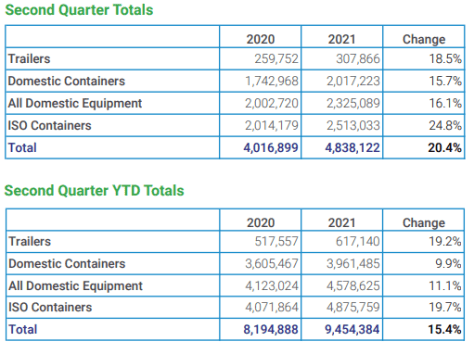
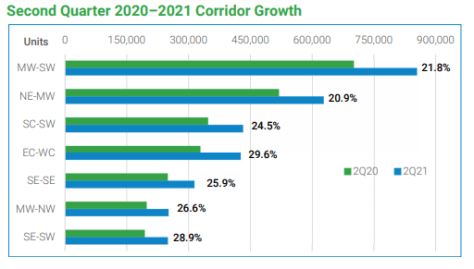
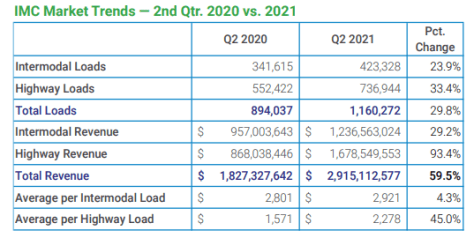
Q2 is the second consecutive quarter with double-digit gains in international traffic and the third with positive improvements. Robust performance was bolstered by weak comparisons and soaring U.S. imports. As with last quarter, international volumes advanced in nine of the ten IANA regions. Mexico, the only region to decline in Q2, faltered 3.9%. However, this is one of the smallest regions, representing only 3% of the total international volume. International moves rose at comparative levels of 32.5% in the West and 32.6% in the East. And while growth rates were very close, Western improvement was more impactful as almost 30% of all international volume originates in this region.
Solid intermodal growth is expected over the remainder
of 2021. Strong domestic demand coupled with weak comparisons will bolster future gains. Intermodal volumes are forecasted to advance an estimated 9% during 2021. International traffic is anticipated to lead the annual improvement by rising almost 13% in 2021. Domestic container moves are expected to rise just above 6% over the course of the year, while trailer loads are estimated to gain between 1.5% and 2.5%.
In Q2 of 2021, total IMC loads rose significantly again, up 29.8% from last year. Q2 2020 volumes were down for IMCs, falling 10.0%, as COVID-19 slowed almost everything. Highway loads were up slightly more than intermodal loads, but both surged during the current quarter. Highway loads rose 33.4%, and intermodal loads grew 23.9% during Q2. Also, highway loads were up over 30% for all of the last three months, while intermodal loads slowed a bit as both April and May increased nearly 30%, but June was up only 11.5%. Total revenue rose in Q2, climbing 59.5% from 2020. Most of that surge was in highway activity that jumped 93.4%, reflecting the 45.0% rise in average revenue per highway load. Intermodal load revenue rose 29.2%, just a bit higher than volume because the average revenue per intermodal load was up just 4.3%. The normal growth from Q1 to Q2 happened again in 2021 with total loads up 6.7%, and total revenue increasing 9.7%. Part of that was due to intermodal volume and revenue slowing down significantly in February 2021 because of the weather.
Trucking Industry Outlook
Trucking posted modest quarter-over-quarter volume growth in the second quarter of 2021. Seasonally adjusted tractor-trailer loads were up 1.1% quarter-over-quarter. While dry van loadings had led growth in Q1, it was the only segment to experience a small decline in Q2 of 0.3%. Refrigerated loadings increased 1.4% q/q while all other loadings were up 2.1%, which is a reflection of the industrial sector’s recovery after lagging the consumer sector.
Short-haul tractor-trailer loadings were the only length of haul to decline in Q2, easing 1.3% quarter-over-quarter. Short-haul had also been the only drag in volume in Q1. The strongest quarter-over-quarter growth was in the super long haul which was up 2.2% quarter-over-quarter. Long-haul rose 1.6%, and medium-haul was up 0.9%.
Trucking volume was 14.0% higher in Q2 than in the same 2020 period. Comparisons range from being up 8.2% in short-haul to a 19.4% differential in long-haul. Dry van was 18.8% higher. refrigerated was up 7.8%, and all other segments were 11.6% above Q2 of 2020.
Active truck utilization – the share of seated trucks engaged in hauling freight – stood at 100% in Q1, basically in line with the extreme tightness seen in late 2017 and early 2018.
Hiring in for-hire trucking finally showed some signs of strength at the end of Q2 as payroll employment rose by 6,400 jobs, seasonally adjusted. The sector remains 38,300 jobs, or 2.5%, below February 2020 on a seasonally adjusted basis, although on an unadjusted basis, for-hire employment has essentially recovered to February 2020 levels.
While June’s job growth was the strongest since November, the first half of the year remains relatively weak with the addition of just 7,600 jobs, seasonally adjusted. By comparison, for-hire trucking in Q4 of 2020 had added nearly 29,000 jobs – the most in any three-month period in 25 years.
It is unclear how much loosening, if any, trucking has seen in the headwinds for adding drivers. Although the licensing of new drivers presumably has improved since the heights of the pandemic, hard data is lacking.
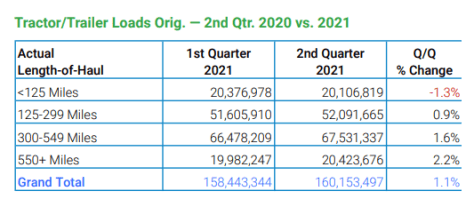
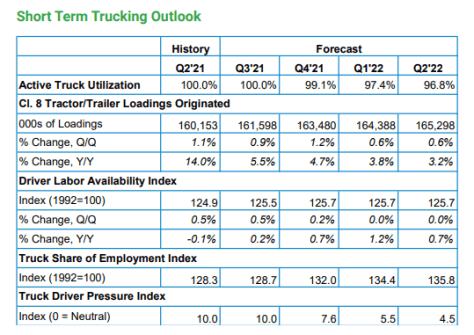
Net orders for Class 8 trucks are finally coming back down to normal levels. After orders of 40,000 or more in each month of Q1, they decreased to nearly 35,000 in April and moderated further to the mid-20,000s in April and June. However, one clear factor in the decline is that order boards for 2021 have been filled and manufacturers had not yet opened the boards for 2022.
Truck freight has not shown any signs of weakness, though it is showing indications that growth might have peaked. Total spot market volume by the end of June was off the peak in May, although the flatbed sector was mostly responsible. Dry van and refrigerated volumes through June were holding at near-record levels if the year’s two big spikes – February weather and the International Roadcheck inspection event in May – are excluded. Moreover, spot rates might also have peaked, but they have not moderated significantly yet.
Freight volumes are expected to slow but experience steady q/q growth into 2022. For 2021 as a whole, truck loadings are forecasted to be 7% higher than 2020 levels.
Freight demand pressures are becoming more complicated. Automotive sales are starting to slide based on low production due to the semiconductor shortage. This bottleneck could keep demand high for an extended period. The large infusions of consumer stimulus that the economy saw in January and March appear to be over but advance payments of a child tax credit started in July and run through December could extent consumer spending. On the other hand, a $300-a-week supplement in unemployment payments to around 14 million Americans has already ended in nearly half of U.S. states and probably will not be renewed nationwide beyond early September.
The sunset of generous unemployment benefits could have some near-term implications for trucking capacity as well if it turns out that those benefits have been a constraint on drivers returning to work. Active truck utilization is forecasted at 100% through Q3 and an easing to only about 99% in Q4. However, this forecast does not assume a significant increase in driver employment as generous unemployment benefits end. Therefore, the forecast risk would seem to be mostly on an easing of active utilization rather than a hardening of it.
Another issue that bears watching is the ongoing surge in small new trucking companies since the middle of 2020. However, if the spot market begins to cool, many of these mostly one-truck operations might rush back to the security of employment with larger carriers.
Intermodal remains highly competitive with trucking due to very high rates and tight driver supply. This situation will likely continue at least into early 2022, however, could be affected by a quicker stabilization in the trucking market, as reflected by a peak in truck spot metrics.





Leave a Reply